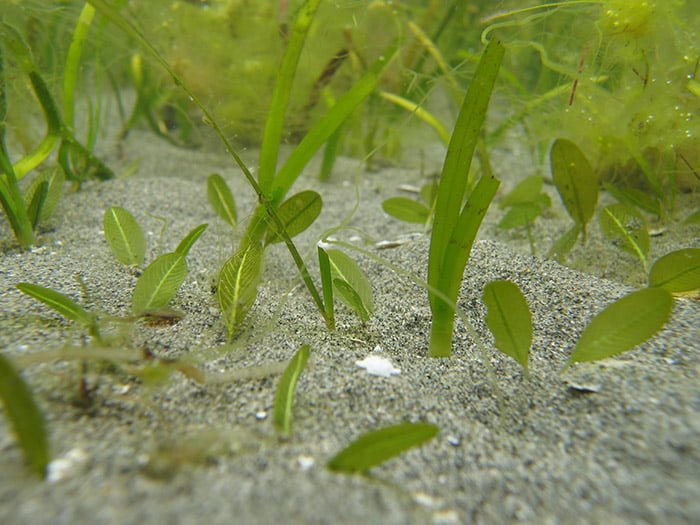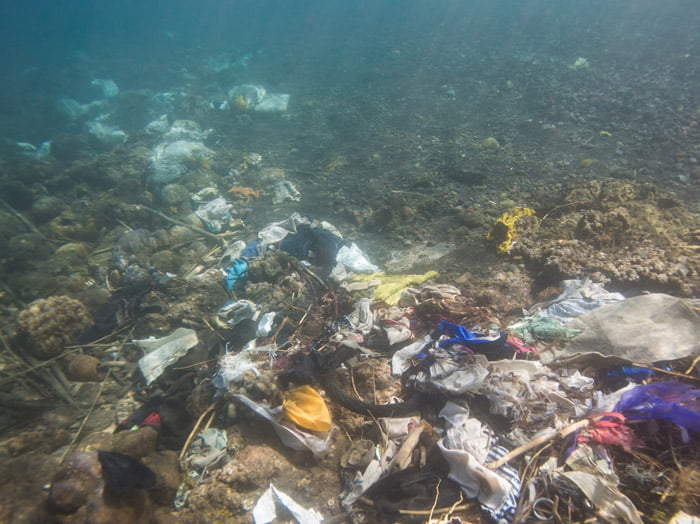Seagrass meadows are the third most valuable ecosystem in the world after estuaries and wetlands.
Seagrasses are marine flowering plants that form dense underwater meadows in shallow coastal waters. Unlike seaweed, which are marine algae, seagrasses have roots, stems and leaves, produce flowers and seeds, absorb nutrients and photosynthesize. With over 70 species found in shallow waters on every continent except Antarctica, seagrass meadows are the most widespread coastal ecosystems in the world.
Seagrass meadows are among the most productive and valuable ecosystems on Earth. They support biodiversity by providing food, habitat and safety for other marine organisms, maintain water quality by filtering sediment and pollutants, reduce erosion and protect coastlines by absorbing wave energy and stabilizing the seafloor, and mitigate climate change by capturing and storing large amounts of carbon. The rich biodiversity that depends on seagrass meadows supports local and global fisheries productivity and food security.

What are Ecosystem Services?
An ecosystem includes living components, including animals, plants and micro-organisms, that interact with their non-living environment and function as a single unit. Through these functions, ecosystems directly and indirectly support human communities: the benefits provided by ecosystems to humans are described as ecosystem services.
Ecosystem services can be categorized into four broad categories
Regulating
the ecosystem processes that enable the planet to be suitable for human life, such as regulation of climate, carbon storage, flood control, water purification and pollination.
Supporting
the ecosystem services necessary for the maintenance of all other ecosystem services, such as biomass production, production of atmospheric oxygen, soil formation and retention, nutrient and water cycling, and habitat provision.
Provisioning
the products humans can extract from ecosystems, such as food, fresh water, wood, fiber, genetic resources and medicines.
Cultural services
the non-material benefits that people obtain from ecosystems, such as spiritual enrichment, intellectual development, recreation and aesthetic values.
Want to know more?
Out of the Blue: The Value of Seagrasses to the Environment and to People (2020)
Millennium Ecosystem Assessment (2005)
Regulating
Carbon Sink, Clean Water and Protecting Coastlines
Seagrass meadows protect coastlines from erosion and flooding by absorbing wave energy and stabilizing the ocean floor with their extensive root systems. They also act as a natural filter, trapping particles and sediment suspended in the seawater, and absorbing pollution from surface runoff. This natural filtration also removes bacterial pathogens capable of causing disease in humans and marine organisms by up to 50% and helps to control the spread of harmful algal blooms by reducing microalgae.
By filtering water and capturing the sun’s energy, seagrass improves its surrounding environment, creating a cleaner and more viable habitat for all marine creatures.
Seagrass meadows pump out a staggering ~100,000 litres of oxygen per hectare each day
Seagrass meadows are excellent carbon sinks, meaning they are capable of absorbing and storing large amounts of carbon dioxide. Seagrass has an excellent capacity for absorbing and accumulating carbon in the oxygen-depleted seabed, where it decomposes much slower than on land. This oxygen-free environment traps carbon in the sediment and dead plant material, which can then remain buried for hundreds of years.
Seagrass meadows alone account for 10% of the world’s ocean capacity to store carbon despite occupying only 0.2% of the world’s oceans. This amounts to approximately 27.4 million tons of CO2 annually.
Seagrass meadows capture and absorb carbon up to 35 times more efficiently than rainforests and, while rainforests bury carbon for decades, seagrass can store carbon for millennia.
The extensive system of roots and rhizomes that underpin seagrass meadows stabilize the seabed and provide protection against coastal erosion. As unpredictable and extreme weather events such as tropical storms and hurricanes become more common, this stabilizing effect also helps to reduce flooding by dissipating wave energy. This has a huge impact on the safety and economic security of coastal communities.
Seagrass meadows dissipate 40% of wave energy, protecting coastlines from erosion.
Supporting
Habitat and Biodiversity
Seagrass ecosystems are a key habitat for marine biodiversity. The extensive meadows formed by seagrass are not only a critical food source for grazing herbivores, such as dugongs and sea turtles, but they also provide valuable habitat to invertebrates and fish, which in turn attract predators such as sharks and octopus. Seagrass meadows also act as important nursery grounds for a range of sea creatures, providing shelter for eggs, larvae and juveniles from predators and strong currents. Without this nursery service many species cannot reproduce.
A single acre of seagrass meadow supports 40,000 fish and 50 million small invertebrates.
Provisioning
Products for human use
The sheer number of species that depend upon seagrass meadows as a habitat and nursery raises their importance for subsistence and commercial fisheries. Fishers around the world rely on seagrass meadows due to the abundance and diversity of fish and invertebrate species that it supports.
Humans have used seagrass for over 10,000 years – to fertilize fields, insulate houses, weave furniture, thatch roofs, make bandages, and even to fill mattresses and car seats.
Seagrass meadows support the production of a fifth of the world's fisheries
Cultural services
Non-material benefits for humans
Seagrass meadows offer intangible cultural benefits, including aesthetic value and opportunities for recreation. People particularly enjoy seeing the animals that seagrass supports, such as dugongs and turtles, and the enjoyment taken from experiences such as snorkeling and diving over seagrass meadows, birdwatching, and recreational fishing are examples of how seagrass improves human life in intangible ways.
Seagrass also contributes to creating a sense of place, and for communities and fishers who live and work in coastal areas seagrass can be an important part of their heritage and identity, with older generations passing knowledge and skills of how to fish and glean in this unique environment.
Threats
Although seagrass meadows are fundamentally important to human life, their value is largely overlooked. On a global level, there is no reliable data available to benchmark targets for seagrass protection, and no country in the Indo-Pacific has yet set a measurable goal for seagrass protection.
With seagrass remaining largely unmonitored and unmanaged, we are witnessing a global trend of rapid and continued seagrass habitat loss and degradation, driven by unsustainable practices in coastal regions. The coastal location of most seagrass meadows allows for relatively easy access and multiple uses, exposing seagrass ecosystems to both terrestrial and marine based threats. According to the IUCN Red List of Threatened and Endangered Species, 14% of seagrass species are at elevated risk of extinction.

Seagrass meadows are one of the most rapidly declining ecosystems on Earth.
Natural impacts to seagrass include storms and other extreme events, such as floods and droughts that affect water salinity, disruption of seagrasses by predators as they search for food and grazing by herbivores, such as dugongs and sea turtles.
Human threats to seagrass include dredging, water quality degradation due to agricultural and industrial pollution and run-off, land reclamation, irresponsible boating practices, destructive fishing practices and coastal development.
Natural and human induced threats have led to a 29% loss in global seagrass meadows over the last century.